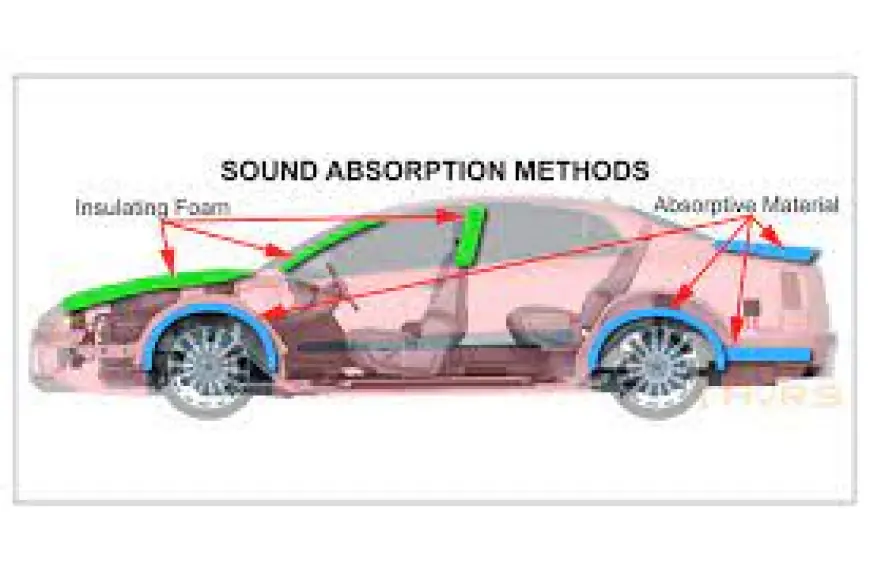Global Automotive Market 2030 Size, Share & Insights
Another vital growth driver for the automotive market is the rapid integration of advanced technologies that are redefining the functionality, safety, and intelligence of modern vehicles.

The global automotive market is undergoing a seismic shift, spurred by rapid technological advancement, changing consumer demands, environmental mandates, and supply chain innovations. Valued at USD 3.11 Trillion in 2024, the market is expected to reach USD 3.82 Trillion by 2030, growing at a compound annual growth rate (CAGR) of 3.5% during the forecast period. This transformation is redefining mobility as we know it—introducing not just smarter and greener vehicles, but also reshaping ownership models, production strategies, and regulatory frameworks worldwide.
Emerging Trends Reshaping the Global Automotive Market
1. The Digital Car: Integration of AI and Connectivity
Artificial Intelligence (AI) is no longer a futuristic concept—it’s now embedded in the very fabric of modern automobiles. From predictive maintenance alerts to intuitive infotainment systems, AI is at the core of how vehicles operate and interact with users. Voice assistants like Amazon Alexa, Google Assistant, and OEM-developed AI interfaces (e.g., Mercedes-Benz’s MBUX and BMW’s iDrive) offer personalized and hands-free control.
Additionally, AI-driven Advanced Driver Assistance Systems (ADAS) such as adaptive cruise control, lane-keeping assist, and collision warning systems are redefining safety standards. Human-Machine Interfaces (HMI) like gesture control and eye-tracking technology further enhance the driver’s experience.
2. EVs Stealing the Spotlight
Electrification is arguably the most disruptive trend in the global automotive ecosystem. With global governments committing to phasing out fossil-fuel-powered vehicles and investing in charging infrastructure, Electric Vehicles (EVs) are gaining rapid momentum. Battery innovations, particularly in solid-state and lithium-ion technology, are improving range, reducing costs, and enhancing safety. Automakers are forming alliances and investing in dedicated EV production lines to stay ahead in the race.
3. Shared Mobility and Subscription Services
The traditional car ownership model is being reimagined. Ride-hailing, car-sharing, and vehicle subscription services are appealing to urban consumers who prioritize flexibility and cost-efficiency. As urban populations rise and parking becomes scarce, the shared mobility economy is expected to reduce the number of vehicles per capita while increasing total vehicle usage.
4. Fleet Electrification and Commercial Innovation
Light Commercial Vehicles (LCVs) and Medium & Heavy Commercial Vehicles (MHCVs) are being electrified to support sustainable logistics and urban deliveries. With online retail surging post-COVID, fleet operators are increasingly investing in electric vans, buses, and long-haul trucks, reshaping the commercial vehicle landscape.
Download Free Sample Report: https://www.techsciresearch.com/sample-report.aspx?cid=16833
Market Drivers Fueling the Automotive Boom
1. Policy Push and Regulatory Support
From California to Norway, governments are encouraging the shift to cleaner transportation through tax incentives, subsidies, zero-emission zones, and EV adoption mandates. Several countries have set timelines for banning the sale of new internal combustion engine (ICE) vehicles, giving automakers a clear roadmap for future production.
2. Consumer Demand for Innovation
Modern consumers, especially millennials and Gen Z, demand more than transportation—they want seamless digital experiences. This has propelled the integration of 5G connectivity, cloud-based navigation, vehicle-to-everything (V2X) communication, and personalized in-car entertainment.
3. Urbanization and Infrastructure Growth
Rapid urban development has necessitated smarter and more efficient transportation. Governments are expanding road infrastructure, investing in smart traffic systems, and encouraging low-emission transport, creating a favorable environment for vehicle sales and innovation.
4. Recovery from COVID-19 Supply Chain Disruptions
The automotive industry showed remarkable resilience during and post the pandemic. Though supply chains—particularly semiconductor availability—were disrupted, the lessons learned have led to vertical integration, reshoring of production, and the digitization of supply chain processes.
Industry Key Highlights
- MHCVs—An Unexpected Growth Engine: Although smaller in volume, Medium and Heavy Commercial Vehicles are emerging as high-revenue segments due to infrastructure development, smart logistics, and clean transportation mandates.
- Electric Propulsion Gains Ground: BEVs and PHEVs are outpacing hybrids and CNG vehicles in sales growth due to falling battery costs and government incentives.
- South America Rising: Brazil and Argentina are becoming focal points for global automakers due to favorable trade policies, increasing local manufacturing, and demand for affordable EVs.
- Software-Defined Vehicles: The future car is more software than steel. Over-the-air (OTA) updates, subscription-based features, and data-driven services are generating new revenue streams.
- Battery Recycling & Second-Life Use: As EV batteries age, new industries around recycling, repurposing, and battery-as-a-service (BaaS) are taking shape.
Segmentation Overview
By Vehicle Type
- Passenger Cars
- Light Commercial Vehicles (LCVs)
- Medium & Heavy Commercial Vehicles (MHCVs)
By Propulsion Type
- Electric Vehicle (EV)
- Hybrid Electric Vehicle (HEV)
- Natural Gas Vehicle (NGV)
- Fuel Cell Electric Vehicle (FCEV)
- Diesel Vehicle
- Petrol Vehicle
By Region
- North America
- Europe
- Asia-Pacific
- Middle East & Africa
- South America
Regional Analysis – Spotlight on South America
South America, and particularly Brazil and Argentina, is emerging as the fastest-growing automotive region. The economic rebound post-pandemic, domestic manufacturing resurgence, and growing middle-class demand are key contributors. Brazil is seeing traction in ethanol vehicles, while also laying groundwork for EVs. The region's vast untapped rural market, combined with urban mobility demands, makes it an attractive investment for automakers.
Competitive Analysis: Global Players and Strategic Moves
Top 10 Companies in the Global Automotive Market
- Volkswagen AG – Leading the EV transition with ID-series and software development.
- Toyota Motor Corporation – Doubling down on hybrids and hydrogen fuel cell tech.
- Mercedes-Benz Group AG – Luxury electric sedans and strong AI integration via MBUX.
- Ford Motor Company – Heavy EV investments and electric pickup truck innovation.
- Honda Motor Co., Ltd. – Focusing on hybrid technology and global market expansion.
- General Motors – Ambitious EV roadmap and strong push into autonomous mobility.
- Suzuki Motor Corporation – Dominant in affordable compact cars and emerging markets.
- BMW AG – Known for premium electric offerings like the i-series and autonomous R&D.
- Nissan Motor Co., Ltd. – Pioneer of affordable EVs with the Leaf and upcoming Ariya.
- Hyundai Motor Company – Strong EV and hydrogen tech pipeline with global aspirations.
These players are competing not just on product quality and price, but also on mobility innovation, user experience, and digital services. Joint ventures, tech partnerships, and software arms are becoming the norm.
Future Outlook: Toward an Intelligent and Electrified Era
The automotive market is on the cusp of a major transition—from metal-and-oil machines to smart, electric, and connected mobility solutions. By 2030:
- EVs could account for over 30% of global vehicle sales.
- Fully autonomous vehicles may start limited commercial operations.
- The line between automaker and tech company will blur even further.
- Subscription and shared mobility could overtake traditional ownership models in urban areas.
- Environmental regulations will push OEMs to achieve net-zero emissions across value chains.
OEMs that pivot quickly, invest in R&D, and build ecosystems around digital mobility will be best positioned to lead in this new era.
10 Benefits of the Automotive Market Research Report
- Accurate Market Sizing: Understand global automotive sales and forecasts by type and region.
- Strategic Insights: Make informed decisions with detailed competitive and consumer trend analysis.
- Future-Ready Trends: Stay ahead of innovations in EVs, AI, ADAS, and HMI.
- Risk Assessment: Identify geopolitical, economic, and technological risks.
- Opportunity Mapping: Discover new markets and vehicle categories for growth.
- Detailed Segmentation: Analyze data across vehicle types, fuel systems, and global regions.
- Supply Chain Evaluation: Review trends in logistics, sourcing, and production.
- Policy Impact Analysis: Gauge the influence of global EV mandates and green policies.
- Customization: Receive tailored research insights based on business needs.
- Actionable Recommendations: Get data-driven strategies for market entry and expansion.
Conclusion
The global automotive industry is no longer defined by steel, gasoline, and horsepower alone. It is becoming a convergence point for software, energy, and intelligent systems, underpinned by sustainability and customer-centric innovation. As the industry evolves, those companies that can skillfully integrate digital ecosystems, clean energy solutions, and flexible ownership models will emerge as future leaders. While challenges such as supply disruptions and high R&D costs persist, the long-term potential of the automotive market remains strong and full of opportunity.
Contact Us-
Mr. Ken Mathews
708 Third Avenue,
Manhattan, NY,
New York – 10017
Tel: +1-646-360-1656
Email: [email protected]
Website: www.techsciresearch.com
What's Your Reaction?
 Like
0
Like
0
 Dislike
0
Dislike
0
 Love
0
Love
0
 Funny
0
Funny
0
 Angry
0
Angry
0
 Sad
0
Sad
0
 Wow
0
Wow
0



















































